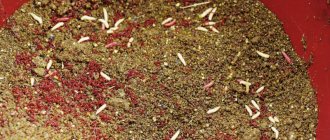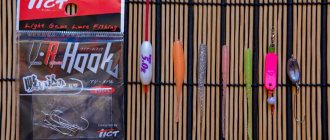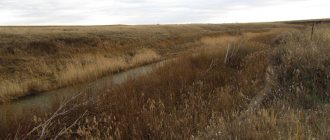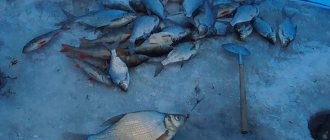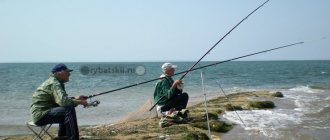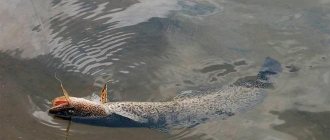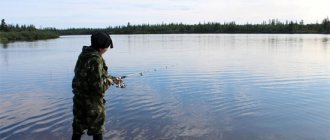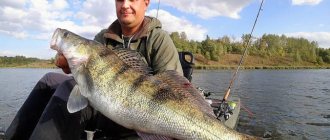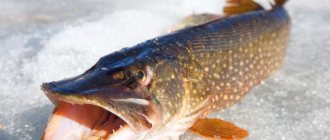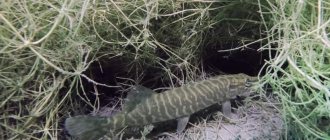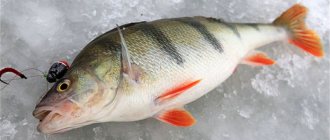Fishing in November
The last ten days of autumn give all fishing fans the opportunity to catch perch, pike, asp or pike perch.
In addition, the catch of roach, carp or crucian carp will be a pleasant addition. Depending on the weather and the week of the month, the fish will bite differently. Considering that the first half of November, albeit occasionally, pleases with windless sunny days, amateurs and professionals can get a catch of all types of fish (naturally, taking into account the population in a particular body of water). At this time, predators quickly cut through the surface throughout the entire depth, but the crucian carp sinks as low as possible.
Starting from the second half of November, the weather conditions are no longer so favorable: the temperature is close to zero degrees, it rains, and the atmospheric pressure decreases. At this time, herbivorous fish are no longer caught, leaving the reservoir at the complete disposal of predators.
Fishing in November with spinning rod
The degree of heat capacity of water is quite high; accordingly, a river or lake cools slowly, in layers. Due to the rapid decrease in air temperature, small-sized fish go into the very depths and practically do not move (stand in holes). Therefore, professionals recommend using spinning rods suitable for catching large specimens. Large fish in cold water do not fall asleep, but only lose sharpness in movement.
Video about catching a predator with a spinning rod in the last month of autumn
Pike 6,500 kg on Kuasamu
For bait, it is better to opt for jigs (small silicone fish with a characteristic color to attract a predator). In this case, any wiring can be used, it is only important to take into account the features of the bottom and the current (whether it exists or not). After conducting a series of tests, it was found that in most cases it is better to catch a predator using vertical wiring with a head weighing within 7 grams. As for the fishing line, the ideal solution here would be to take a braided cord.
This is interesting about fishing in November:
- burbot;
- asp.
Fishing with a float rod and feeder
In November you can fish with live bait. This way you can catch burbot or the same pike; it is better to take larger live bait, this way it is easier to interest the fish. Predators can be found quite large in size, but large specimens of ordinary fish are extremely rare. As a rule, this is a small thing, but, on the other hand, it can be used as live bait. Usually, these are something like small breams and roaches.
Fishing in November with a fishing rod
Those who are not used to fishing with a spinning rod should not deny themselves the pleasure of fishing with a regular float rod. Hunters should remember that for a long time the fish lived in comfortable conditions, but with the advent of the first cold weather, it received serious stress. Accordingly, she can do things completely unexpected. Therefore, when going fishing in November, it is recommended to stock up on several types of bait. Read more about roach fishing in November here.
In addition, the fisherman must be especially careful. The water in November is almost always clean and transparent, making it possible to visually determine in which places the fish are located. Considering that you won’t be able to cast a float rod far, it should be thrown to the places where the flock has stopped.
Before you start fishing, you need to accustom the fish to the fact that there is food in this place. For this, it is also recommended to take several types of bait. The first cast of the fishing rod should be done no earlier than 40 minutes later. Read also about fishing for bream in November.
Where to look and what to use to catch pike in November
When starting to catch pike in the last month of autumn, the fisherman should know that the fish is preparing for the onset of winter. At this time, she tries to make maximum reserves, which is why she begins to eat a lot. Her appetites now are comparable to those before spawning. Thanks to this, you can hunt pike with mugs, live bait, or catch with a spinning rod.
As for baits, it is better to choose them in large sizes, because in November pike are attracted by large-sized prey, so you can take a “shaker” or a “vibrating tail”. Regarding “live bait,” there are also some peculiarities: fish often bite poorly if the bait is live, but completely inactive, but at the same time, pike are caught on already dead fish.
We must not forget about the color preferences of pike. The fish goes well both on a standard metal spoon and on balancers of bright colors: white, yellow, green. It is preferable to start your hunt in the morning or just before sunset. At lunchtime, such fishing will never bring the desired results. Details about catching November pike with a spinning rod
Spinning fishing in November in central Russia
On stagnant bodies of water
Despite the rapid cooling of water in shallow waters, pike catch there with varying success until the freeze-up. Even in cold November, the predator continues to feed, and there are also local outbreaks of biting. The main thing now is to find and tease the fish.
On enclosed ponds and lakes, first check the local holes and depths, because most of the fish are now there. All our baits and methods of presenting them are the same as they were in October.
Perches respond best to medium-sized “rubber” with a light weight, and the twister or vibrotail had to be practically dragged along the bottom - this is the only way to get the maximum number of bites. But pike now prefer oscillating spinners and wobblers with lazy action.
Before the ice freezes, it is advisable to check the “toad grasses” and “budding” ponds again. You often find an amazing bite here. All the grass in the “toad beds” has died, and the pike has to move around and actively search for prey. And in the large “puddles” that were cut off, the predators simply ate everything that was there and are now brutally hungry.
It is interesting that in cases of the first unstable ice breaking up, there are still outbreaks of active biting. Personally, I caught pike with varying success before the final freezing of reservoirs.
The situation is somewhat different in small flood lakes connected by channels with large water. A lot of fish come here to spawn, and with a stable level and the availability of food, they often linger until they stop. And only the approaching freeze-up drives the “whitefish” and pike and perch out of the potentially “morbid” lake. Anticipating the onset of winter, all the fish gather at the exit in advance and at one fine moment slide down the channel into deep water. This is where you can fish all day from a good spot.
In relatively deep dammed reservoirs, pike and perch are usually concentrated in a narrow strip on dumps into a flooded, steeply bending river bed. Moreover, the concentration of perch in such places is so dense that “striped” ones bite on almost every trip. True, autumn predators are already “inhibited” and prefer very slow step-by-step retrieving of a small twister or vibrating tail near the bottom.
On small deep rivers
On small deep rivers on clear, cold days in November, schooling perch become noticeably active. Fishing is especially interesting because all the “sailors” are now concentrated in deep holes and whirlpools. Knowing such places well, we can only check them one by one, pulling out up to a dozen tails from each “point.” Especially a lot of “striped fish” accumulate in the lower reaches and especially at the mouths of deep rivers. From time to time, pike are also found here along with perch.
A universal bait is a small twister or vibrotail on a possibly light jig head. Along with the standard white and pearlescent models, brighter colors are increasingly working - especially lemon and fluorescent yellow with glitter.
It happens that the perch is active, and then no special “tricks” are needed. But usually, on the contrary, you have to use the slowest movements - up to “striking”, dragging and long stops at the bottom. If only he would take the bait
On large rivers and reservoirs
Catching predators in the pre-winter season is still the most productive in the so-called “drinking” reservoirs. Closer to the beginning of freeze-up, the water level there decreases significantly, which concentrates all the fish in the riverbed part of the reservoir. But predators still feed in relatively deep areas near the riverbed - this is where you need to catch them. And then, even in unfavorable weather, we will not be left without fish.
True, we catch mostly small pikes and perches, and occasionally pike-perch - but there are quite a lot of bites. Fish are now equally caught both with foam rubber baits and with rubber baits. On days of high predator activity, standard step retrieval brings success. But if frequent idle “jabs” begin, you will have to change gears - lighten the load and even catch “drawn” (extremely slow, “low” retrieval with periodic dragging along the bottom, with stops and leaving the bait motionless). Bites, as a rule, occur either at a stop or at the moment of a smooth “movement” of the bait from its place. This method is especially popular with perch and pike perch.
Such “hot spots” of reservoirs as sharp turns of the main channel, holes, deep bays and the mouths of tributaries still work well. Pike are consistently caught here using jig baits, and perches and pike-perch are often bitten. Despite the colder weather, the fish bite does not stop.
In those reservoirs where the water level is high, the picture is different - the fish are quite widely dispersed throughout the reservoir. Nevertheless, here, too, on the deep edges, medium-sized perches and pike are caught quite successfully, and pike perch “outs” also occur.
The main catches during this difficult transitional time occur, as a rule, on days with stable weather and in the afternoon.
The situation on large rivers in the prolonged pre-winter period also becomes more complicated. The bite is usually weak and very unstable - the predator literally has to be “tortured.” However, even here, during periods of relatively stable weather, success can be achieved. The main bait remains a fairly heavy jig, but there are other options.
For example, on the Oka River in November, in some places one-kilogram pike perch is caught, and at dawn sometimes specimens weighing 4-6 kg “fall in”. It takes the “fanged” one on rocky slopes from 3 to 6 m, but prefers flat, actively vibrating wobblers. In cold water during the day, a silver-blue color works well; in the morning and evening, a bright lemon belly is desirable.
It’s interesting that in November it’s not uncommon to catch 0.5-1.0 kg bream in the mouth using small foam baits – and how many more empty bites there are! In some pits, just at this time, skilled fishermen manage to specially catch white bream with a spinning rod! And not to get caught, but to catch. Here it is especially important to find a suitable place and use minimal weight weights and mini-foam rubber. But the fact itself! Wow!
However, winter sooner or later comes into its own, and spinning fans are left with only winter fishing.
Winter spinning
The situation on non-freezing reservoirs at the beginning of winter is actually the same as on ordinary rivers in the pre-winter period - difficult. Fish do not feel the air temperature, but near open water, even the coldest, the temperature is always positive.
That’s why fishing, like late autumn, is the hardest.
For example, statistics from winter spinning competitions, which have been held on the Moscow River in mid-November for many years, show that only a third to a quarter of all participants come home with a catch. The main catch of fishermen is pike, pike perch, and perch. This also takes into account the fact that at the beginning of winter the total catches are larger, and record specimens are caught. True, the temporary “abundance” is directly related to the November release of water in the Moscow River, when narrow “paths” are cleared under the steep banks and shore fishing becomes widely available.
The main winter baits are foam rubber and small rubber. The bite is usually weak, sometimes the fish simply “hangs” on the hook, and predators are often found already in leeches. But in favorable stable weather there are short “zhors” and loud “blows”. Bites usually occur far from the shore - in holes and river-bed dumps.
While the frosts have not yet “pressed down”, some small rivers remain open, where you can also visit with a spinning rod and a light jig. But the situation here is unstable - there are bites, but the average catch is only one or two pike.
Middle Volga
In November, fishing generally ends in large Volga reservoirs. Only at the beginning of the month on quiet days is it still possible to catch good pike, pike perch and perch in the deepest places. Of the baits, the best results here are shown by heavy jigs and jigs.
But in the middle of the month snow falls on the ground and the first ice appears on small tributaries of the Volga. The winter cold begins and with it the general freezing. At the end of the month, as a rule, the Gorky Reservoir is covered with ice. The Volga and its large tributaries – the Oka and Vyatka – are finally rising. Alas, this year's spinning season is over.
Perch fishing in November
At this time of year, perch is excellently caught both in clear water and on a surface slightly covered with a crust of ice.
However, the fisherman should remember that in November schools of perch have already formed in a large population and move at a sufficient depth. The question of choosing bait remains relevant, and here wobblers show the best results. They must be sinking, medium-sized, equipped with jerk wiring. Fishing for perch in November is both made more difficult and easier by the clarity of the water, so jig lovers are advised to use dark-colored rubber lures.
This species of fish hunts mainly during the daytime. It is preferable to take it at dawn, but you can try your luck at lunchtime. The perch is no less active before sunset. Weather plays a significant role and significantly affects the catch. If you don’t want to return empty-handed, then you need to wait until the weather is relatively warm in November and the atmospheric pressure does not fluctuate.
What kind of fish is more effective to catch in November?
This month, the peaceful inhabitants of reservoirs begin to move away from the shores, their appetite is moderate, and they do not experience severe hunger. It is good to catch roach and bream near large river depressions in November. Catchable baits include bloodworms, maggots, and worms. In warm weather, you can also hunt for carp, which does not ignore not only bait of animal origin, but also plant-based cake and canned corn grains. An excellent bite often occurs during the Indian summer.
November will be the most productive November for those who like to hunt predators:
- perch (activity especially in large individuals);
- pike (everyone has a zhor);
- pike perch (bites are frequent);
- bull (excellent bite);
- chub;
- burbot;
- soma.
Among the common trophies in the fisherman's cage are pike perch, perch and pike.
Fishing for pike perch in November
When the hunter's goal is pike perch, fishing becomes very exciting. Compared to the two predators presented above, this type of fish is prone to active movement throughout the reservoir. He constantly changes his place in search of food.
It is best to catch pike perch in the last month of autumn at great depths, in those places where they usually gather in a flock, hunt or spend the winter. Another place where a hunter will always find pike perch is where small fish gather.
Fishing is ideal in the morning or evening, because it usually becomes inactive during the day. However, there are professional fishermen who successfully catch pike perch throughout the night, using only donka.
Beginners can try their luck at catching pike perch with a jig, but it is important to choose the right size bait (medium), with a stepped or smooth retrieve. This is due to the fish’s affinity for fast-moving bait; slow bait is not among its interests. Read more about spinning fishing for pike perch in November here.
What to catch pike perch with
Throughout November, pike perch continues to move actively on the river and practically does not sit in ambush waiting for prey. This leads to a peculiarity when catching it: pike perch will always react to a fast-moving bait; stationary or sedentary options are not interesting for it. In open water, pike perch will prefer silicone, worms, and twisters of an acidic translucent color. They choose a heavier jig; the pike perch has already sank to the bottom and that’s where you should look for it.
The fanged one is lured along the ice with balance beams. It is possible to catch it on a donkey, but night time will be more successful.
When choosing a winter fishing rod for pike perch, you should give preference to options with stiffer whips.
Fish for burbot
The freshwater representative of cod is sought after the water has cooled; during this period, it leaves its shelter in search of food. He prefers to hunt for small fish in clean areas of reservoirs without silt and vegetation.
In open water, they don’t lose hope of catching burbot on a donk; ice conditions force fishermen to change gear; the most effective are burbots, and they are used at night.
Let's go for grayling
In the northern regions, with the onset of cold weather, grayling is actively caught; this type of whitefish will respond perfectly to artificial flies and spoons thrown by a spinning angler. As soon as the reservoirs are covered with ice, a small jig will be able to attract the attention of this fish.
Bream fishing in November
If a decision has been made to hunt bream, then fishing in November should be locally located in places where the deep water begins almost right next to the shore. The ideal option in this case is fishing from a boat. Bream is actually quite a fastidious fish, and if the reservoir has a sandy bottom, then in the autumn it will be practically impossible to catch it.
In November, it is better to opt for reservoirs with a clay or rocky bottom. Unlike predators, you need to start catching bream no earlier than 10 am. And if the first bite has already begun, then you can be sure that this will continue throughout the next day. However, in rare moments the fish will become quiet.
As for gear, the ideal ones are the familiar donka with a feeder, and, of course, a feeder. The length of the rod should not exceed three meters (this is quite enough for normal casting).
Bream's favorite baits in November are bloodworms and maggots. You can also prepare mastyrka (cook split or round peas for several hours, when the water has boiled away, add corn flour or semolina, boil a little and turn off). To achieve a stable aroma, add honey, vanillin and a little sunflower oil to the finished mass. Read also about catching bream in November on a feeder.
Fishing in November - How and where to fish?
Fishing in November is primarily about catching predatory fish. November weather is simply perfect for pike and perch fishing; burbot fishing is good in November; pike perch are often hooked. At the same time, schools of large bream can also be found at feeding points at depth. Let's take a closer look at what kind of fish to catch in November, how fishing in November differs from fishing in other autumn months, how fishing in November for pike, perch, pike perch and burbot, and also how to catch bream, crucian carp and roach in the last month of autumn.
Beginner fishermen need to know that fishing in November can be divided into three periods, each of which is characterized by its own characteristics:
- fishing in November before the ice freezes;
- fishing directly during ice cover;
- fisherman on the first ice.
It should be noted that the timing of ice formation for water bodies in the central zone of the European part of Russia is almost the same, with the exception of the northern regions, where freeze-up in some years is observed even in the last ten days of October, and the southern regions, where it usually occurs in the first half of December. In some years, the southern reservoirs of the Krasnodar Territory do not freeze at all, and successful fishing continues in November in open water. In the Kuban, vimba and shemai are well caught with bottom rods; predatory fish take lures and live bait.
We will find out how to fish in each of the indicated periods, what gear to use and what kind of fish to expect.
Fishing in November before freeze-up
In the first ten days of the month there is constant rain, sometimes with wet snow, and when it clears, frosts occur. During this period, fishing is not much different from fishing in October.
The fisherman's calendar for November notes that, if the weather is favorable, fishing with spinning rods and mugs continues until freeze-up in November. Fishing with mugs gives good results in November, but at low temperatures it is difficult and requires thorough physical preparation. In November, in good weather, fishing with float rods continues for perch - for fry and roach - for bloodworms (preferably in lakes).
Fishing in November during freeze-up days
In the first days of freeze-up, fish usually take throughout the day. Pike perch bite better in the early morning and in the evening, before dark. Fishing is most successful on cloudy, calm days with low temperatures. You need to start fishing in ponds, lakes and backwaters of large bodies of water.
Fishing in November on first ice
After freeze-up, fish are caught from morning to evening. More successful fishing is in relatively warm, cloudy and calm weather. Almost all types of fish can be caught well with winter sports gear on the first ice:
- In November, fishing with large winter lures is good for pike perch, pike perch, and large perch;
- In November, medium-sized perch is caught with small spoons; it is better to catch it at shallow depths near sunken snags and grass, using a worm or bloodworm as bait;
- Fishing in November with a jig with a bloodworm attachment gives excellent results - this way you can catch perch and roach;
- In November, using winter float rods at depths with a slight current, you can catch bream, chub, roach, silver bream, perch, dace, and gudgeon.
- They use winter live bait rods to catch pike in November; fishing will be more successful if you fish in deep places, and it is better to use ruffe, perch or crucian carp as live bait.
- fishing in November for burbot is more effective with bottom fishing rods at night; it is better to fish with ruff or small roach;
- Fishing in November during fishing - all types of fish, except pike and pike perch, at shallow depths with a smooth current;
- In November, pike perch, large perch, and pike come to the girders from the depths.
Fishing in November is possible with both winter and summer gear. This month is a transitional stage from open water fishing to ice fishing. Large rivers and reservoirs, despite the low air temperature, remain ice-free. Water has a high heat capacity and it takes some time for it to cool throughout its entire thickness. In November, in such water bodies (large rivers, bays, reservoirs) the height of fishing for predatory fish is in full swing. The greatest interest this month is pike fishing.
Pike fishing in November
The pike continues to have an autumn feeding period, which in its intensity can only be compared with the pre-spawning period. In November, pike can be caught with a float rod using live bait, with mugs, and by trolling, but the most exciting and exciting is fishing with a spinning rod. Any bait is suitable for catching pike in November, the main thing is that they should be larger. Pike is preparing for winter, which is why it is especially attracted to large prey. The most suitable bait is a spinner; you can also catch pike with a vibrating tail. But catching pike with live bait may not live up to expectations. But if the pike reacts reluctantly to a live but inactive fish, it responds perfectly well to a dead one. You can catch pike at the end of autumn using both regular spoons and large bright balancers in white, yellow and green colors. Less popular among fishermen are the brick-red balancers, but they say that the fish also go for them, but generally don’t pay attention to the silver ones. The best time for pike fishing in November is the first morning hours. There are chances to catch fish before sunset. Fishing for pike during the day is almost a waste of time.
Perch fishing in November
As already mentioned, fishing for perch in November can take place both in open water and on the first, not yet thick ice. The main thing to remember is that in November the perch have already gathered in fairly large schools and are staying at depth. At this time, it is most effective to catch it with small wobblers, which sink better, using jerking movements of various animations. Also at this time, the use of jig equipment justifies itself, but since at this time the water becomes quite transparent, jig heads are equipped with rubber baits of dark or natural colors. Fishing in November for perch using spinners can also bring results, but it is not as effective as in August or September. When going fishing for perch in November, keep in mind that perch is a diurnal predator, so catching it is possible throughout the day. Of course, the most promising time for catching perch in November is early morning and evening, it is believed that it is during these periods of time perch is most active. Fishing for perch in November is most effective on relatively warm days, with steady or gradually increasing atmospheric pressure and a slight wind from the south or west.
Fishing for pike perch in November
It is very interesting to catch pike perch in November. Unlike pike, it actively moves in search of prey and rarely lies in ambush. Fishing in November for pike perch is more effective at depth, where it gathers in schools and either looks for wintering holes or hunts. Also, pike perch can almost always be found in places where small items accumulate. Fishing for pike perch in November is more successful in the evening or in the morning; pike perch is not particularly active during the day. Many fishermen fish for pike perch exclusively at night. The most popular way to fish for pike perch in November is to catch pike perch with a jig. The baits themselves should be of medium size, color does not matter. To catch pike perch with jig bait, several types of fishing are used. Namely, stepped and smooth, the pike perch prefers when the bait moves quickly; it is not attracted to slow retrieval. Pike perch can also be caught using oscillating spoons. In addition, many fishermen catch pike perch in November using donka. Donka is mainly thrown when fishing for pike perch at night. Tackle for pike perch must be strong, since in November pike perch is almost always caught in large sizes: a strong fishing line and a metal leash are your faithful helpers.
Burbot fishing in November
November is the month when burbot is caught purposefully. Fishing in November for burbot is more successful in its feeding areas at night stops for small fish. Also, as the water gets colder, burbot begins to visit the coastal zone. Burbot does not like areas where the bottom is covered with dense vegetation or silt. The best places where burbot fishing is most successful are considered to be those where pebble rifts or sandstones are followed by holes about 2 meters deep without a current. Fishing for burbot in November occurs at night and all bites occur after sunset. As for the gear in November, you can successfully use ordinary donks with a 0.3 mm fishing line and a sliding sinker. Hooks use single hooks of the first number, and a leash with a diameter of 0.25 mm is required. In November, the best bait for this predator is live bait. Most fishermen believe that the best live bait is the ruffe or gudgeon, since these fish, like burbot, lead a bottom-dwelling lifestyle and do not cause him to be particularly wary of their presence in his hierarchy. In addition to live bait, you can use frogs, in this case you need to follow one rule: you need to hook such bait by hooking it on the back paw.
Fishing for crucian carp in November
Fishing for crucian carp in November is very dependent on the weather, because the November crucian carp is already beginning to lose activity and gradually settles down for the winter at the bottom. Fishing for crucian carp in November is more successful when the water warms up, that is, during the day and on days with rising temperatures. In warm water, crucian carp is more active. Since with the onset of cold weather crucian carp loses activity due to a decrease in metabolism, it is best to refuse bait, mainly due to the fact that crucian carp moves only in very limited spaces in November. When fishing for crucian carp, the main thing to remember is that crucian carp are not active in November, and there is no need to play with the bait. It's best to leave it motionless. And remember that you need to recast if it doesn’t bite for a long time. The best rod for catching crucian carp in November is a light one, about 4.5 -5 meters long. A telescopic rod is quite suitable, as they are quite long and light. The float must be sensitive so that its slightest movement can be noticed, because the fish are not particularly active in November, and you need to pay the slightest attention to the movement of the float. For fishing in November for crucian carp you should use hooks No. 2.5-3.5.
Bream fishing in November
With the arrival of November, bream begin to group at depths near the pits in which they spend the winter. Fishing in November for bream near the rocks, where the depth starts almost from the shore, or from a boat will be effective. Remember that in November bream mainly stays at medium and deep depths; the bottom prefers a clay or rocky bottom; it is better not to choose a sandy bottom. In November, the bream bite does not begin in the morning; the fish become active around 10 o'clock, but the bite is steady and continues throughout the day with varying success. Of the gear, the most promising in November will be either a feeder or a regular donka with a feeder. A three-meter rod for catching bream in November will be sufficient; it will allow you to cast to the distance you need. It is better to use bloodworms or maggots as bait in November. as well as a sandwich made from them. Don’t forget about the mastyrka, a very catchy bait when fishing for bream. It is prepared from split or round peas, which are boiled for several hours (until the water has completely boiled away), mixed with semolina or corn flour and cooked for a few more minutes. Honey, sunflower oil and a little vanillin are added to the finished homogeneous mass.
Roach fishing in November
Finding roach in November is not difficult. The favorite places for roaches are quiet bays with depths of more than a meter, not heavily silted and overgrown. Fishing in shallow holes near steep banks is very promising; it will be a plus if there are trees on the shore leaning towards the water. Very often, roaches are found on the borders of reed thickets with clear water. Fishing for roach in November is more successful if you use sensitive gear. A lightweight rod 6 meters long is equipped with a 0.08 mm fishing line. The float should also be light, with a load capacity of up to 0.4 grams. Catching roach in November is more successful if you give preference to animal baits. Basically, at this time, dung worms, bloodworms, various larvae or maggots are used. Moreover, you can use maggots that have already pupated. Good fishing for shell meat. It has been noticed that roach react very actively to a moving bait, so many fishermen slowly play along with the bait after casting, which brings good results. The composition of bait for fishing for roach in November is simple: breadcrumbs, fried ground rolled oats, cake and dried daphnia (aquarium food).
To guarantee a guaranteed catch when fishing, we recommend using the appropriate bait and bite activators. This attracts a large number of fish to the fishing grounds and significantly increases the chance of a good catch!
